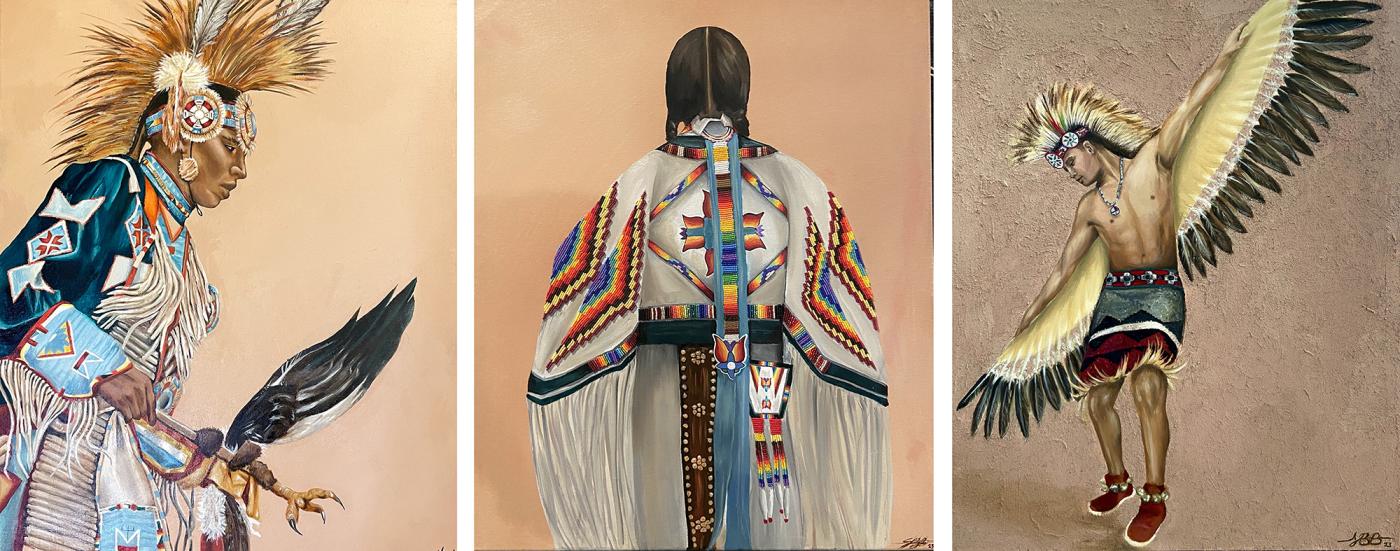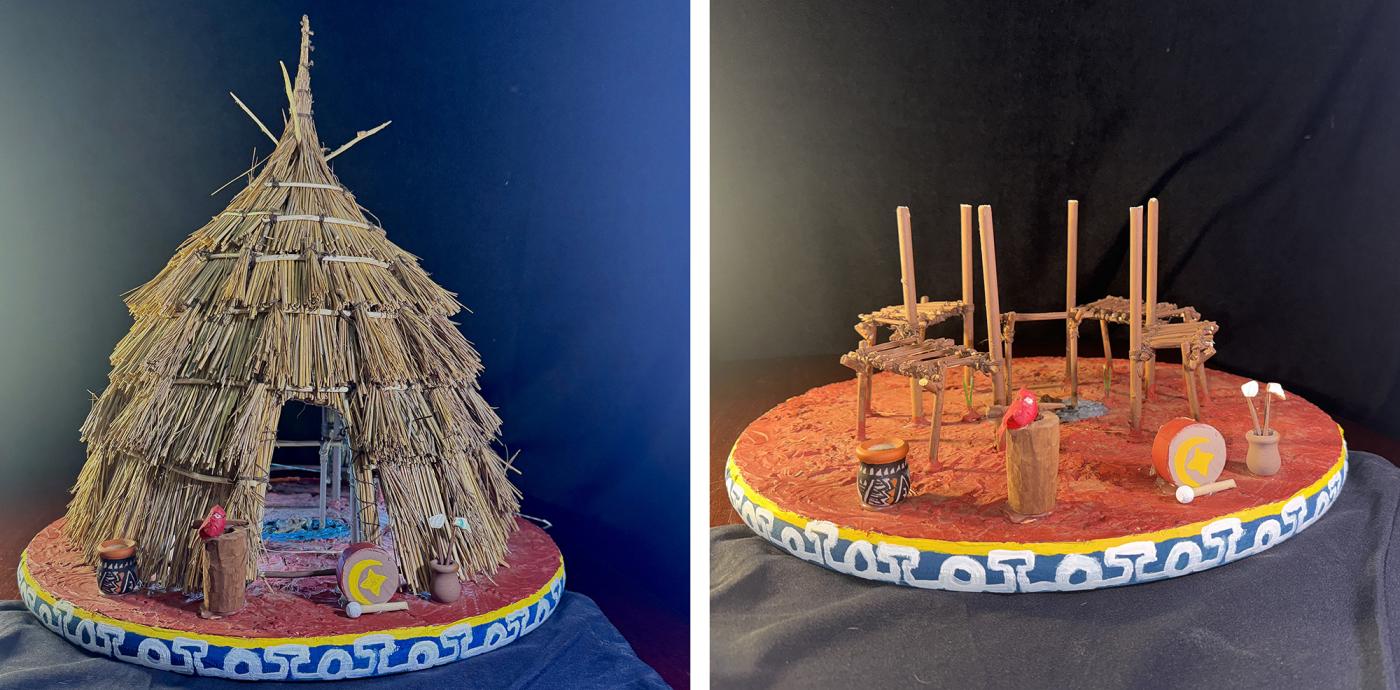The artwork below was submitted as part of the 2024 Young Tribal Leaders Art Contest, and selected by a committee of Division of Environmental Services and Cultural Resource Management (DESCRM) and Institute of Tribal Environmental Professionals (ITEP) staff. Three winners were selected*, along with twenty other exemplary works to exhibit online and at the Main Interior Building in Washington, DC.
* Winner: Artist Kimey Begaye (Navajo Nation), Age 23, not featured below
Winner: “Dek'ohananne” by Lakin Epaloose
Description by Artist Lakin Epaloose (Zuni Pueblo), Age 20
The entire body of the artwork encompasses the migration story of not only the Zuni people (A:shiwi), but also the Puebloan communities of the southwest as a whole from a Zuni perspective. These locations extend all the way from the Grand Canyon into what is today known as central Mexico. The elements of water (k'yana), such as in the form of cumulus clouds (awethuya:we), and flora serve as key points in this work. Many of the petroglyphs and pottery designs found throughout each respective area are also depicted in the work.
Winner: “Zuzeca Sapa” by Kassidy Linabery
Description by Artist Kassidy Linabery (Rosebud Sioux Tribe), Age 28
The prophecy of a great Black Snake, spreading across the land, foretells the destruction of the water, the land, and the people. But it also serves as a beacon of hope: the people will have to unite, physically and spiritually, to protect Grandmother Earth.
“ašiihkiwi” (Earth), by Nick Hargrove
Description by Artist Nick Hargrove (Peoria Tribe of Indians), Age 25
Depicted in this traditional Peoria painted hide work is the upper world of order— ruled by ciinkwia, the thunderbird— while the lower world of chaos is ruled by the horned serpent, lenipinšia. In the middle dwells Man, balancing the two extremes through our lives, with many stories and events in our culture being depicted in ways our ancestors would recognize.
“Amazing Environmentalist” by Lisan Tiger Blair
Description by Artist Lisan Tiger Blair (Cherokee), Age 28
Hummingbirds are an integral part of promoting flower growth in the ecosystems they survive in. The more flowers they feed from, the more they spread the vital pollen that is necessary for flowers to grow and thrive. Hummingbirds are amazing environmentalists even if they don't know it themselves.
“Medicine in Movement” by Skylar Blackbull

Description by Artist Skylar Blackbull (Navajo Nation), Age 22
The three paintings are part of one series called, "Medicine in Movement." They represent the physical and spiritual beauty in Native American heritage. The regalia worn represents a story. The grass dancer and the eagle dancer mimic the animals in nature, while the shawl dancer is sharing her own story. Through song and dance we bring our community closer and heal those around us. Through my work, I hope to inspire others to explore the vibrant world of Indigenous creativity, to recognize the beauty and complexity of Native American culture, and to appreciate the diversity that exists within it.
“Mother Earth,” by Devon Borkowski
Description by Artist Devon Borkowski (Rappahannock Tribe of Virginia), Age 23
Mother Earth was a painting made for an Indigenous food sovereignty and food justice event. It depicts native stewardship of the natural world, shown through an Indigenous mother caring for the earth as her own baby.
“Remain Strong,” by Mayiki PlainBull
Description by Artist Mayiki PlainBull (Montana Crow Tribe; Lumbee, Haliwa-Saponi, and Crow), Age 19
This painting has to do with Native American history. The one on the bottom being residential schools. Where they tried to strip Native children of their culture. Then there’s the top one where Native people can finally practice and embrace their culture.
“Dancing Spirit,” by Isis Howell
Description by Artist Isis Howell (Sault Ste. Marie Tribe of Chippewa Indians), Age 18
The title of my painting is “Dancing Spirit.” It’s an acrylic painting with floral, the 7 dance category’s / styles, as well as the 7 grandfather teachings in the sky in the form of their spirt animals in the style of northern lights, mountains, trees, and teepees.
“Twelve More Generations,” by Stacey Williams
Description by Artist Stacey Williams (Ketchikan Indian Community, Tlingit, and Haida), Age 30
Incorporating 12 different skillsets learned through apprenticeships with master weavers in order to continue the thread of knowledge in this utilitarian type of horn spoon basket. Typically used along the northwest coast for transportation of personal items such as utensils in order to maintain order and cleanliness among the population and surrounding environment. Form follows function within usable creations; the impact of climate has undermined the need for certain types of baskets such as those used for harvesting shellfish due to all time recorded elevated PST (Paralytic Shellfish Toxin) levels.
“Oceti Sakowin,” by Chelysa Owens-Cyr
Description by Artist Chelysa Owens-Cyr (Fort Peck Assiniboine and Dakota Sioux), Age 24
This digital piece is called Oceti Sakowin, it’s a self depiction of a Lakota woman in traditional dress, dancing strong and independent; for women are the matriarchs & back bones of all communities. On either side of her are Akicitas or Lakota warriors. As Lakota people we are united as one, the border being geometric tipis in a circle; representing the 4 directions, 4 stages of life, 4 seasons and circle for interconnectedness.
“Carrying A Memory,” by Deshawna Anderson
Description by Artist Deshawna Anderson (Crow Tribe and White Mountain Apache), Age 23
"Carrying A Memory" is a made-in-the-USA beaded purse that promotes the importance of a healthy environment from the perspective of a western climate. The handle is created from a one needle peyote stitch and the front of the purse is a two needle flat stitch.
“Indigenous Resilience,” by Devon Borkowski
Description by Artist Devon Borkowski (Rappahannock Tribe of Virginia), Age 23
The painting “Indigenous Resilience” shows Native resistance in the face of harmful practices that threaten our food sources and ways of life. It was initially made an Indigenous food sovereignty and food justice event.
“Kavirliq Silence” (Red Silence), by Arianna Leuer
Description by Artist Arianna Leuer (Yupik), Age 16
I believe my beadwork falls into the category of culture as well as a little bit of environment. Kavirliq Silence shows a red hand. The symbol of a red hand is a primary way of showing your support to the Murdered and Missing Indigenous Women movement. This issue is, and has been for a long time, a part of Indigenous culture. Furthermore, it helps make our Indigenous women and others aware of this topic, that is so deeply rooted into our lineage. It is embedded into many of our cultures. I, as an Indigenous person, want to make this impact on our culture more visible to others around me.
I would also say that Kavirliq Silence is included in the environment category. The environment here in Alaska plays a big part in why Indigenous women aren’t found in a timely manner. In Alaska, the snow and frigid temperatures can make traveling or searching for these women very difficult. Which is another reason as to why Indigenous women in our community are not found.
“ni:skha:r?a k?i:s akhå:r?” (A Bird’s Small Grasshouse), by Mikayla “MK” Kerron

Description by Artist Mikayla “MK” Kerron (Wichita & Affiliated Tribes, Muscogee Creek, and Makah Tribe), Age 26
This 3D artwork vividly portrays the essence of a traditional kirikir?i:s (Wichita) Grasshouse, intertwining nature, culture, and climate seamlessly. It features red dirt, emblematic of our ancestral homelands, prairie grasses intricately woven into the cedar frame, and symbolic items like pottery, a corn mill, and a drum narrating our kirikir?i:s creation story through the crescent moon and star. Above all, the piece stands as a testament to the resilience of our traditional homes, designed to weather any climatic challenges.
“Tranquility,” by Chelysa Owens-Cyr
Description by Artist Chelysa Owens-Cyr (Fort Peck Assiniboine and Dakota Sioux), Age 24
This piece is named Tranquility, a digital drawing. The image depicts a young Lakota girl and her dog sitting on the hillside, peaceful and content, overlooking the mountains. Mountain mist clearing as the sun warms Mother Earth, clear blue skies and sun beams that can be seen for miles. Butterflies and dragonflies flying around them signaling that spring is finally here.
“Mother Earth,” by Grace Moore
Description by Artist Grace Moore (Yup'ik, Sitka Tribe of Alaska), Age 23
This piece depicts an arnaq (woman) bearing traditional eyat (tattoos), she is Mother Earth. Below her the colors seen in the nuna (land) and imarpik (ocean), above her the northern lights.
“Orcas,” by Brooke Escobar
Description by Artist Brooke Escobar (Curyung Tribe), Age 30
Orca pattern I created, beaded with delica beads. These hand crafted orca earrings pay homage to the cultural ties that bind Alaska's Indigenous communities with the ocean-life, symbolizing the enduring traditions and the intricate relationship between the sea and our Native culture.
“Rain or Shine,” by Cory Dayish
Description by Artist Cory Dayish (Navajo Nation), Age 28
My art captures modernity, climate, environment, and with a holistic sense of culture through spirituality. Just like nature, the title of my submission is: "Rain or Shine."
“Wacink'sabya” (To live a natural life as the Creator intended), by Kylie Wanatee (ThunderHawk)
Description by Artist Kylie Wanatee (ThunderHawk) (Rosebud Sioux Tribe), Age 19
This 24 x 36 in Acrylic painting depicts the spirit of Unci Maka (Mother Earth), The Star Nation and Turtle Island in harmony and prayer for the well-being of future generations of the Indigenous peoples of North America.
“Our Creation,” by Ahnawake Toyekoyah
Description by Artist Ahnawake Toyekoyah (Kiowa Tribe of Oklahoma), Age 25
I did this piece based of an old Cauígu (Kiowa) story about the seven sisters and also added elements that mean something to us as Kiowa people. Of course if you know the story of the seven sisters you’ll spot them right away in this painting (the Big Dipper) and the famous devils tower that is also key part of our story. The hummingbirds represent the resiliency of my people but also the healing they bring us when we are suffering/ mourning. The cedar we use for prayer for not just us but everyone. The oak leaf represents us Kiowa People, which you’ll see many forms of this leaf in our regalia.
“Stills from Łéétsoh,” by Sabrina Manygoats
Description by Artist Sabrina Manygoats (Navajo Nation), Age 24
October 2023, Sabrina Manygoats measures radiation from the Church Rock nuclear disaster site in Church Rock, Arizona, 15 miles outside of Gallup, NM. An image of a Geiger counter is overlaid with archival footage of Kerr McGee uranium mining operations. Archival footage is of a uranium processing mill located in Ship Rock, Arizona. Depicted is a conveyor system transporting uranium ore to a processing facility where it would be refined into yellow cake
“Restoring Néške'emāne,” by Loren Waters
Description by Artist Loren Waters (Kiowa Tribe and Cherokee Nation), Age 28
"Restoring Néške'emāne" is a 12-minute award-winning documentary film that tells the story of Damon Dunbar, who works to remediate the toxic landscape of a Cheyenne and Arapaho Indian boarding school shut down in the early 1980s by the Bureau of Indian Affairs.
Contact Us
Albuquerque, NM 87104


